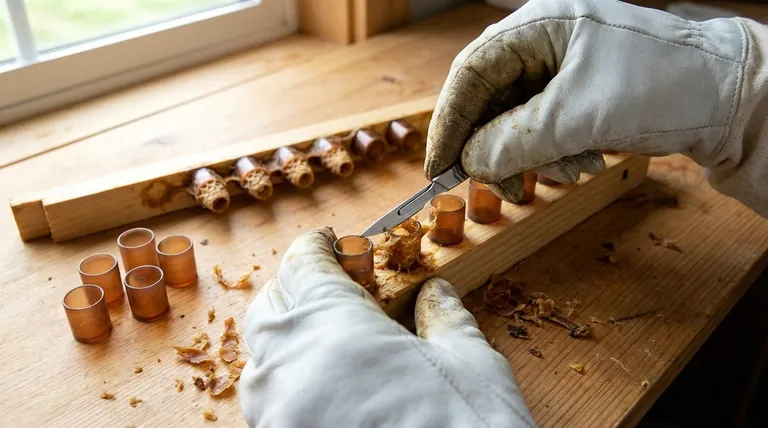In short, when brace comb is built between queen cells, you must perform careful surgery with a sharp knife. Gently trim away just enough of the brace comb to allow the protective cage to fit without putting any pressure on the developing queen cell.
The central goal is to protect the fragile queen pupa at all costs. Forcing a cage over brace comb will almost certainly crush the cell and kill the queen, so precise, gentle trimming is the only viable solution.

The Core Problem: Why Brace Comb Is an Issue
Bees naturally build brace comb to strengthen structures and fill gaps. When rearing queens, this instinct can create a significant problem by connecting adjacent queen cells on a cell bar.
Physical Obstruction
Brace comb acts as a physical barrier. It fills the space where the protective cage needs to sit, making proper placement impossible without first addressing the excess wax.
High Risk of Crushing
A developing queen cell is extremely fragile. Attempting to force a cage over the brace comb will transfer that pressure directly to the cell wall, crushing the delicate pupa inside and destroying your work.
Interference with Emergence
Even if a cage is partially placed, remaining brace comb can block the tip of the queen cell. This can prevent the virgin queen from chewing her way out, trapping and killing her upon emergence.
The Solution: A Step-by-Step Surgical Approach
Treat this task with the precision of a surgeon. The goal is to remove the obstruction while ensuring the queen cell remains completely untouched and undamaged.
Select a Sharp, Clean Blade
Your primary tool must be a very sharp knife, scalpel, or hive tool edge. A dull blade will tear and drag the wax, transmitting damaging vibrations to the cell. A sharp blade ensures a clean, effortless cut.
Use Gentle, Precise Cuts
Do not try to remove the brace comb in one large piece. Use gentle, shaving motions to slowly trim the wax down. The goal is to create just enough clearance for the cage to slide into place without contact.
Support the Cell Bar
Hold the cell bar securely with your other hand to keep it stable. This prevents accidental slips or jarring movements that could damage the queen cells you aren't working on. Work slowly and deliberately.
Understanding the Risks and Common Pitfalls
While the solution is straightforward, there are risks involved that stem from haste or improper technique. Understanding them helps you avoid costly mistakes.
The Danger of Rushing
This is a delicate operation that cannot be rushed. A slip of the knife can easily puncture or slice open a queen cell, instantly killing the occupant. Take your time.
The Fallacy of Force
Never assume you can "gently" push the cage into place. The wax of a queen cell is soft, and even minor, steady pressure is enough to cause fatal damage. If the cage does not fit easily, you must trim more wax.
Incomplete Trimming
Be sure to remove enough comb to provide full clearance around the cage. A cage that is tight against the cell can still cause pressure damage or prevent the queen from emerging cleanly.
Making the Right Choice for Your Goal
Your actions should always prioritize the health and viability of your new queens. This single focus will guide your technique.
- If your primary focus is maximizing queen survival: Always choose careful, patient trimming over any attempt to force a cage into place. The few extra seconds spent cutting are an investment in a successful hatch.
- If your primary focus is hive management efficiency: Recognize that losing a queen cell costs far more time and resources than the moments required to trim brace comb correctly. A steady hand is the most efficient tool in this situation.
Ultimately, protecting your investment in new queens requires patience, a sharp blade, and a gentle touch.
Summary Table:
| Problem | Risk | Solution |
|---|---|---|
| Brace comb between cells | Crushes queen cell during caging | Precise, gentle trimming with a sharp knife |
| Physical obstruction | Prevents proper cage placement | Shave wax to create clearance |
| Incomplete trimming | Blocks queen emergence | Ensure full clearance around the cage |
Protect your queen-rearing success with the right tools. As a trusted supplier to commercial apiaries and beekeeping equipment distributors, HONESTBEE provides the high-quality, sharp grafting knives and durable cell-protecting cages you need for precise, successful operations. Contact our wholesale experts today to discuss your equipment needs and ensure the survival of your valuable queens.
Visual Guide

Related Products
- Brown Nicot Queen Cell Cups for Breeding Queen Bees Beekeeping
- JZBZ Push-In Queen Cell Cups for Beekeeping
- Clear Black Plain Polystyrene Queen Bee Grafting Cell Cups No Lug for Bee Queen Cup
- Plastic Chinese Queen Grafting Tool for Bee Queen Rearing
- JZBZ Type Wide Base Plastic Queen Cell Cups for Base Mounting and Queen Rearing
People Also Ask
- How are the queen cells raised after removing the plugs? Master the Art of Queen Rearing
- What is the advantage of the Nicot Cupkit system? Secure Your Queen Rearing Success with Batch Protection
- What role does the natural swarming process play in queen rearing? Harness the Swarm Instinct for Better Queens
- What are the ideal conditions for raising good queen cells? Achieve Robust Queens with Strong Cell-Builder Colonies
- What should be done with extra queens from grafting? A Strategic Guide for Apiary Management











